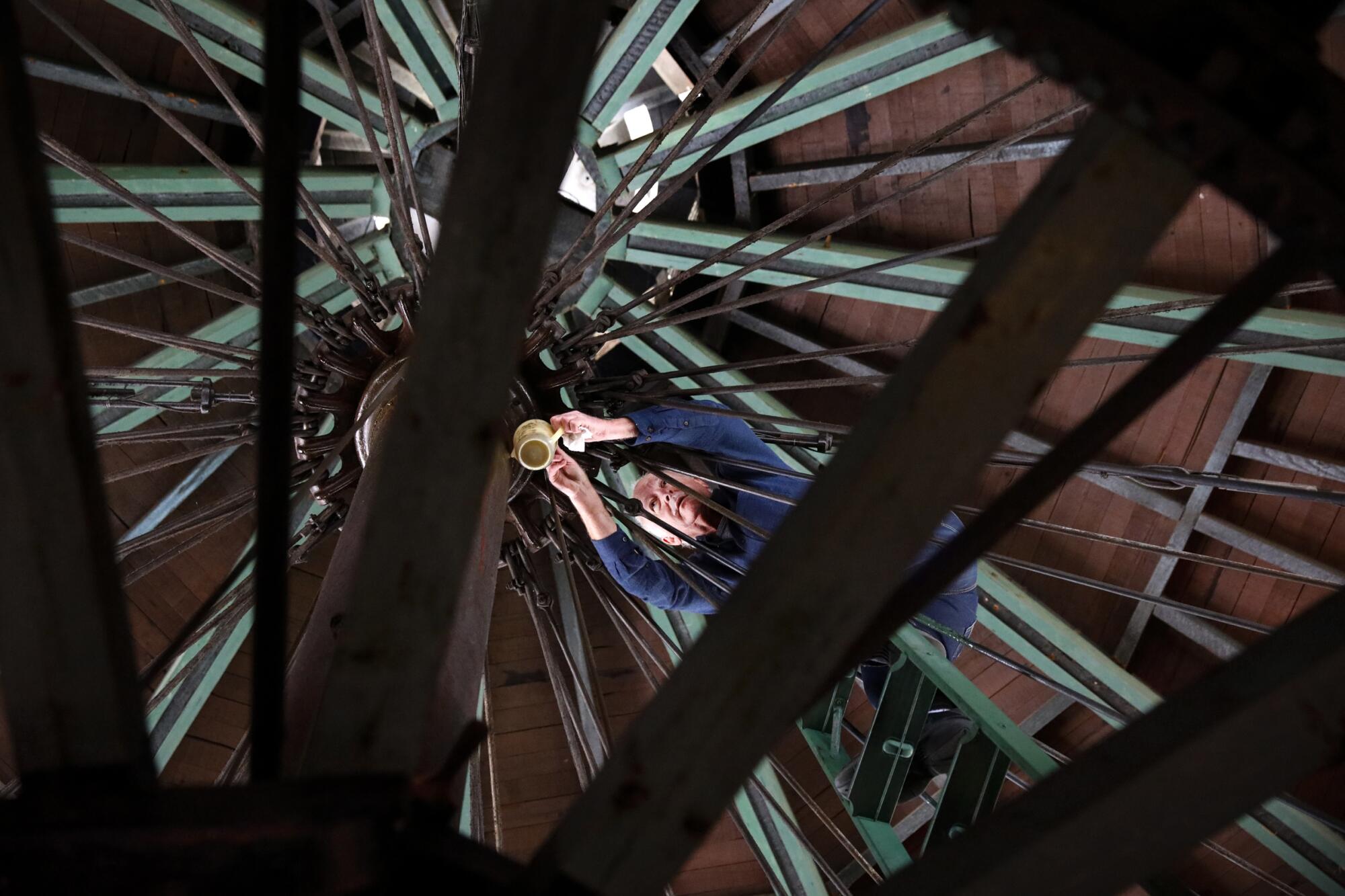
- Share via
SAN DIEGO — For 50 years, Bill Brown has been going around in circles at work.
Don’t feel sorry for him: He runs the Balboa Park Carousel.
He’s stayed on the job that long because he enjoys working at a place where fun is the object and everybody is in a good mood. Now man and machine have become inseparable, preserving for San Diego an attraction that’s more than an amusement ride. It’s a time capsule.
This story is for subscribers
We offer subscribers exclusive access to our best journalism.
Thank you for your support.
The carousel is almost exactly as it was when it started operating in Balboa Park 100 years ago this month. Pretty much the same menagerie of 52 hand-carved wooden animals and four chariots, put in motion by the same 10-horsepower General Electric motor. Same military band organ playing the same music. Same oil paintings adorning the decorative panels. Same opportunities to grab the brass ring.
All that makes it a rarity, even among the few thousand “Golden Age” carousels built between 1890 and 1930. About 150 remain scattered across the country in various stages of original splendor.
Yet this is no museum piece, gathering dust. In 2019, the last full year before the pandemic hit, the carousel was ridden more than 102,000 times.
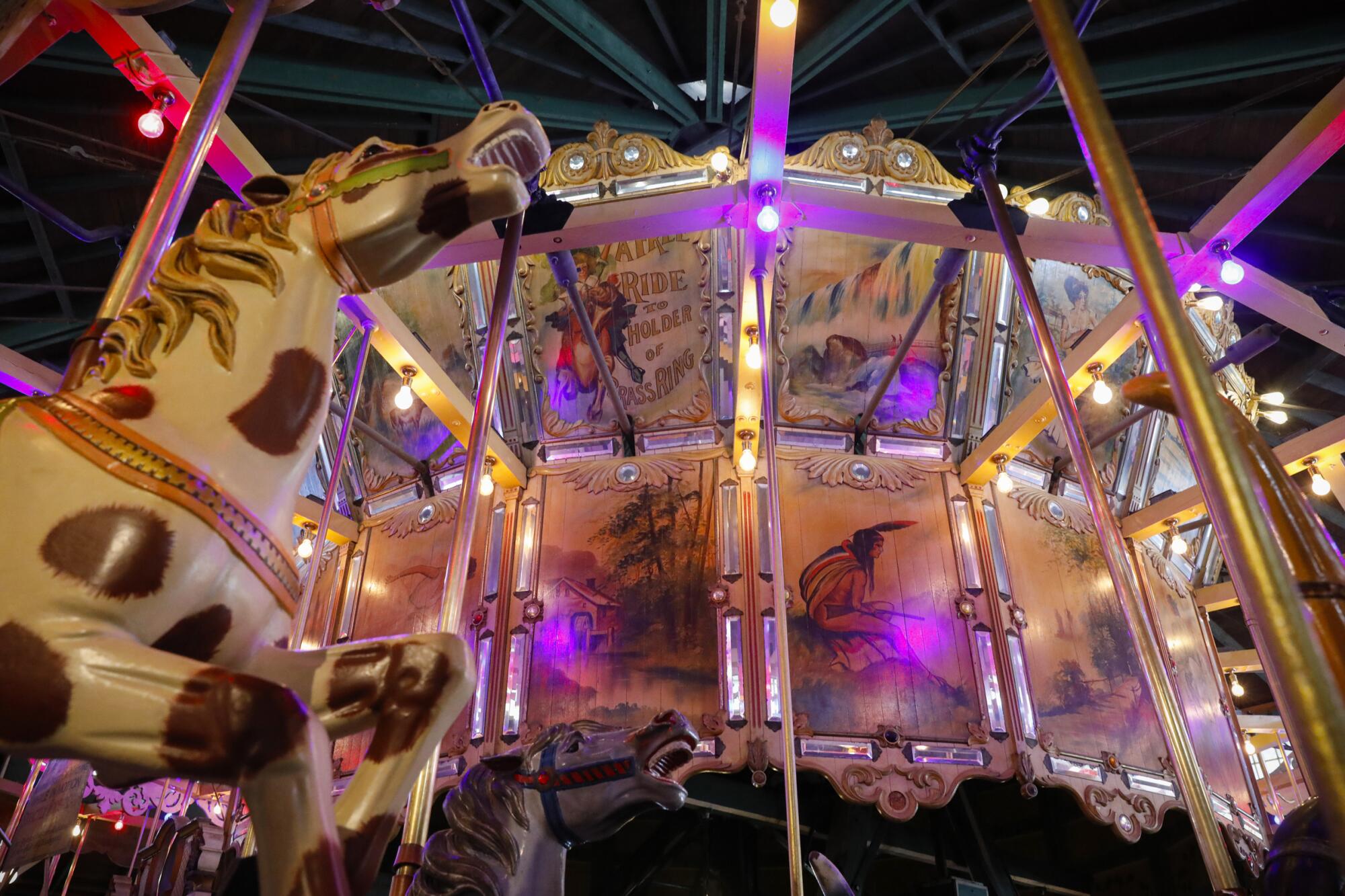
While riding it now, a thought comes to mind: What other attraction in San Diego offers an experience essentially unchanged across 10 decades?
Sitting on the sand at the beach, maybe, if you close your eyes.
There’s another old carousel at Seaport Village, circa 1895. But it’s been here only since 2004, moved from Burbank after stays in other cities, including Dallas and Portland, Ore. Some of its key features have been modified over time.
The San Diego Zoo, incorporated in 1916, looks nothing like it did in its earliest days as a ragtag collection of cages along Park Boulevard, and — unlike the carousel — the animals there now aren’t the animals there then. The Giant Dipper roller coaster in Belmont Park dates to 1925, but its passenger cars aren’t original. The indoor Plunge, also at Belmont Park and of the same vintage, started off as a saltwater pool and is now freshwater.
And the Hotel del Coronado, built in 1888, is intentionally a shell of its former self. While it looks in places much as it always has, inside and out there are modern luxuries.
About the only things modern on the carousel are the LED lightbulbs overhead, a bow to the increased efficiency in illumination that time and electrical engineering have brought.
That the ride has remained essentially intact all these years is a testament to its handful of owners and to the equally small number of managers who have meticulously passed down, mostly by word-of-mouth, the how-tos of carousel maintenance and operation.
The not-so-simple secret of its longevity, according to Brown: “We take good care of it.”
New York to San Diego
Carousels trace their beginnings to 12th-century jousting and cavalry training in Asia and Europe. Horsemen rode in a circle, spearing small rings with their weapons. In time, a version of the exercise was adapted for children, and carousels cropped up in parks and at festivals.
They spread to America and became popular in the 1880s as cities grew and leisure time expanded. Trolley lines took people to beaches and parks where carousels and other amusements were a big part of the draw. Several firms manufactured them, adding mirrors, lights, music and more elaborately carved animals.
The one in Balboa Park was built in 1910 by the Herschell-Spillman Co. in North Tonawanda, N.Y., just outside Buffalo. It went first to Luna Park in Los Angeles and then, three years later, to Coronado’s Tent City, a summer attraction erected on the strand.
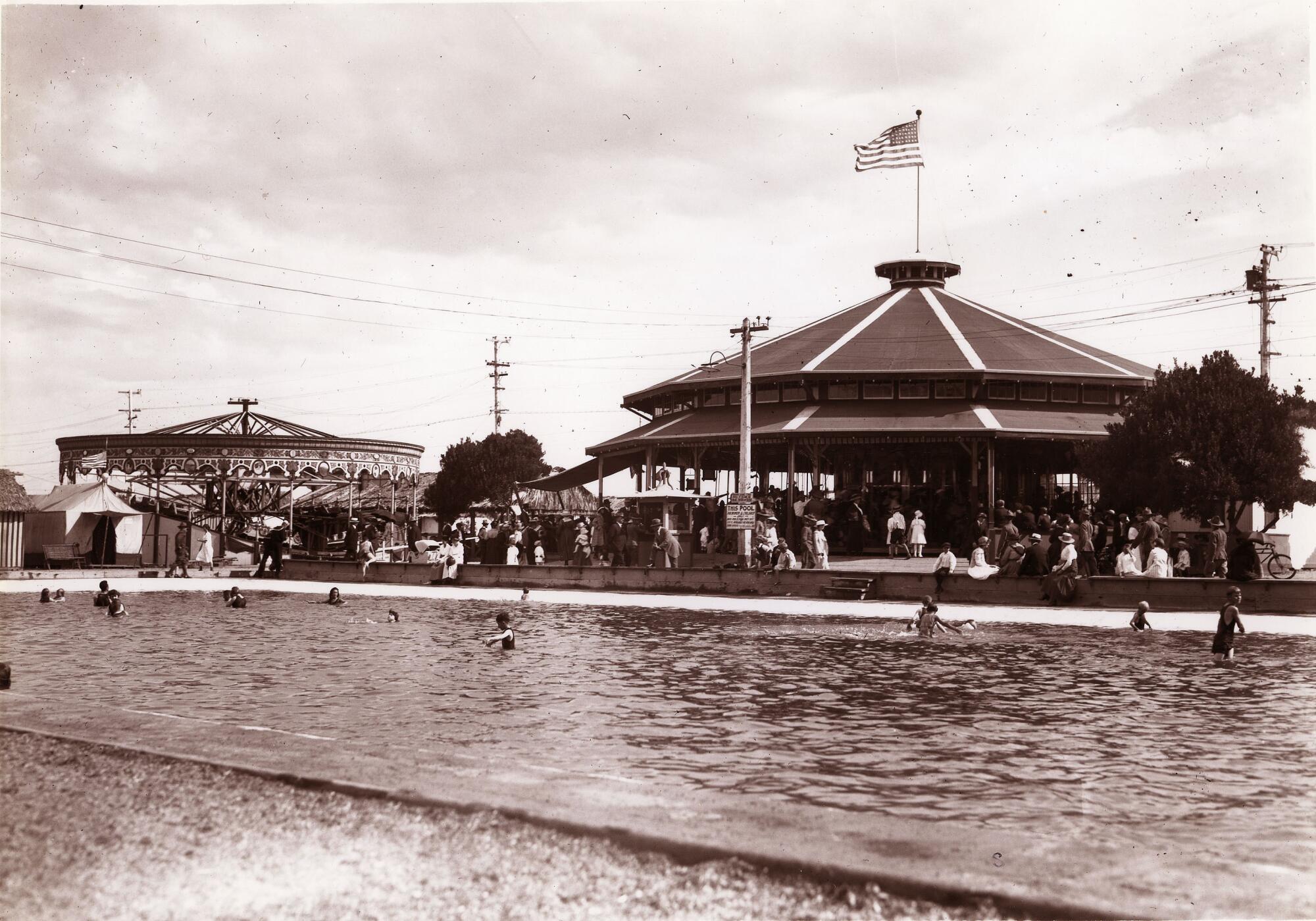
By the early 1920s, the Navy wanted the land in Coronado where Tent City stood. The carousel owner, Harold Simpson, was squabbling with the City Council over licensing fees. He and his wife moved from Coronado to a house in Bankers Hill.
On March 17, 1922, the San Diego Union ran an article about building projects in Balboa Park. It quoted Simpson telling a city committee “that he will open for business tomorrow with a merry-go-round, just inside the entrance to the street railway at the east end of Balboa Park.”
That spot, where the Reuben H. Fleet Science Center is now, was home to the carousel for the next 46 years. In 1968, with plans under way to widen Park Boulevard, the carousel and the building that houses it were moved on a flatbed truck to their present spot near the zoo entrance.
Some people believe the ride was in the park before 1922, that it was barged across the bay to be part of the 1915-16 Panama-California Exposition, then returned to Coronado.
But David Marshall, a local architect who has researched the history, said there’s no evidence the carousel went back and forth for the expo — no photos, no maps, no newspaper clippings, no contracts.
“It’s a nice story,” he said, “but there isn’t any proof that it happened.”
The gaps in the documented history aren’t surprising to Marshall. For many people, the carousel has been an afterthought: always there, no big deal.
In 2007, he put together a collection of 200 postcards in the book “San Diego’s Balboa Park.” He selected them after looking through some 2,500 postcards. Not one had an image of the carousel.
“Everyone loves this carousel, but most don’t realize how rare and unique it is,” said Marshall, who is on the board of the nonprofit Forever Balboa Park, which owns the carousel. “Very few of them have their original elements.”
Late last year, the city approved an application he put together for the ride to be designated as a historic resource. The designation means the city formally recognizes the carousel as a landmark that must be protected and preserved, he said. It also makes the attraction eligible for grants from various organizations.
Forever Balboa Park, which bought the carousel in 2017 and has raised $3 million to refurbish it, has plans to strengthen the 12-sided building that houses the ride, replace the ticket booth, and maybe add restrooms and a gift shop.
There’s always work to be done on something that’s more than a century old. Just ask Bill Brown.
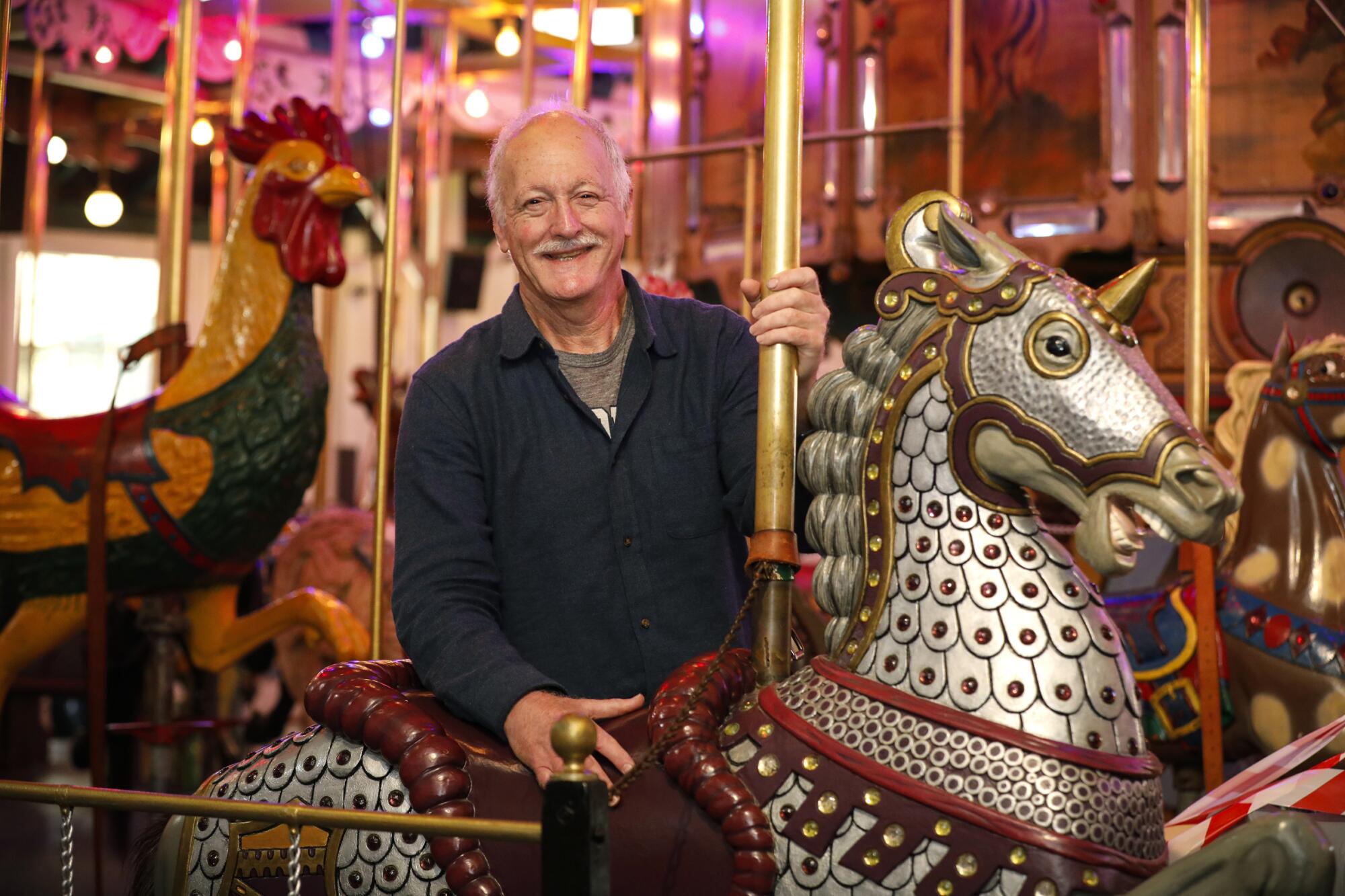
Restoration Tuesdays
Growing up in San Diego, Brown remembers as a kid favoring one of the horses on the carousel’s outside row, a black one. He liked to ride it and grab for the brass ring.
He was 16 when he first started working there part time. “It just looked like everybody was having fun,” he said. He kept working weekends as he finished up at San Diego High School, went to San Diego State University, even as he commuted to Los Angeles for a career composing music for films.
After a while, part time became full time, and the institutional knowledge about the carousel had been passed down to him. What gears to grease, and how often. How to ease off the hand-brake and engage the clutch just so. How to take care of the 102 paper rolls that play the music in the band organ.
Last Sunday, about an hour before the ride opened to the public, he was up on a ladder adding oil to a glass bowl. The oil lubricates a giant bearing that helps turn the carousel. One drop falls onto the bearing every 10 seconds.
Brown wasn’t all that mechanically inclined when he started. Now he knows the carousel better than anybody, a walking encyclopedia. Twice he’s been to the Herschell Carrousel Factory Museum in North Tonawanda to learn more.
He also oversees “Restoration Tuesdays,” when volunteers gather at the carousel to work on the various animals. The menagerie is unusual for its breadth: horses, dogs, cats, zebras, pigs, ostriches, frogs, donkeys, roosters. There’s a lion, a tiger, a camel, a stork — even a sea monster.
Each of them needs a paint job now and then, and some have been done more faithfully than others. When the carousel was run by a Brit, he covered over the Stars and Stripes on a couple of the horses. Uncle Sam, on one of the chariots, became a pirate.
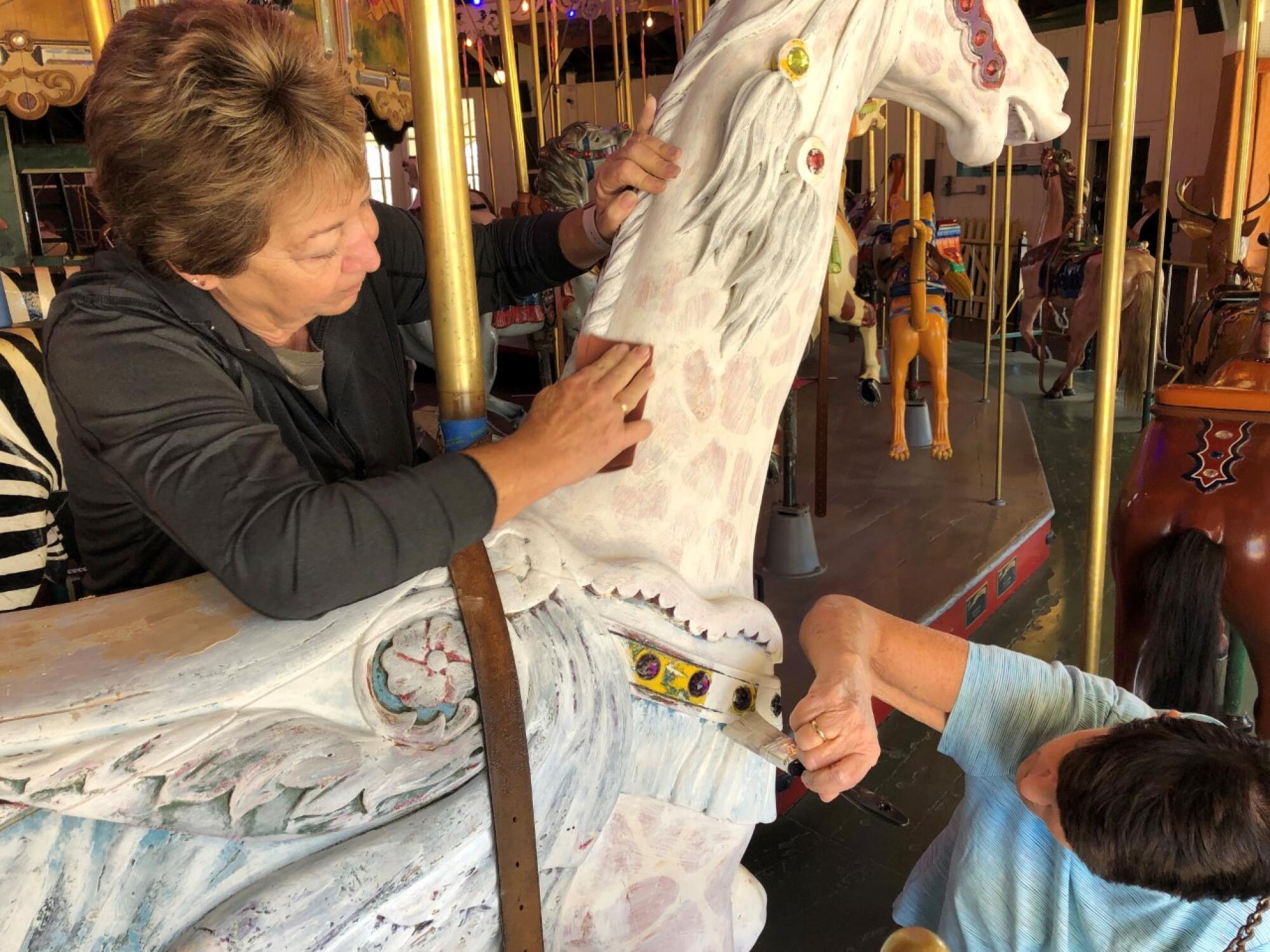
Volunteers sometimes find five or six layers of paint on the animals they are refurbishing. Such was the case for Tracey Ferguson and Gloria Shepard, who have been working on a giraffe since January, sanding and priming it for a new coat.
They’ve named it Kenny, in honor of Ferguson’s cousin, Kenrick Wirtz, who died in 2019. (You get naming rights if you sponsor an animal: $50,000 for the outer row, $35,000 for the inner rows.) They picked a giraffe because Kenny was tall.
Ferguson and Shepard, both in their 60s, live in the San Carlos area. They grew up in San Diego, went to local schools and rode the carousel.
“It’s lasted because people like it,” Shepard said recently as they worked. “They ride it when they’re kids, and then they take their kids to it, and then they take their grandkids. It gets passed along from generation to generation, and it becomes a treasure worth saving.”
They are taking the repainting seriously. They’ve gone to the zoo to look at giraffes, snapped photographs. They want the spots just right.
Before too long, Kenny will be back in action. A rider will run to the giraffe, hop on board and wait. At the center of the carousel, Brown will ring a brass bell, the time-honored way of asking an assistant if it’s OK to set the ride in motion. The assistant will clap twice: All clear. Brown will ring the bell again to acknowledge that he’s heard the claps.
Then he’ll release the hand brake, engage the clutch. He’ll turn over a three-minute sand timer so he knows when to stop the ride.
The organ is playing, and somewhere out there, in the imagination, other music joins it. The Talking Heads.
Same as it ever was.
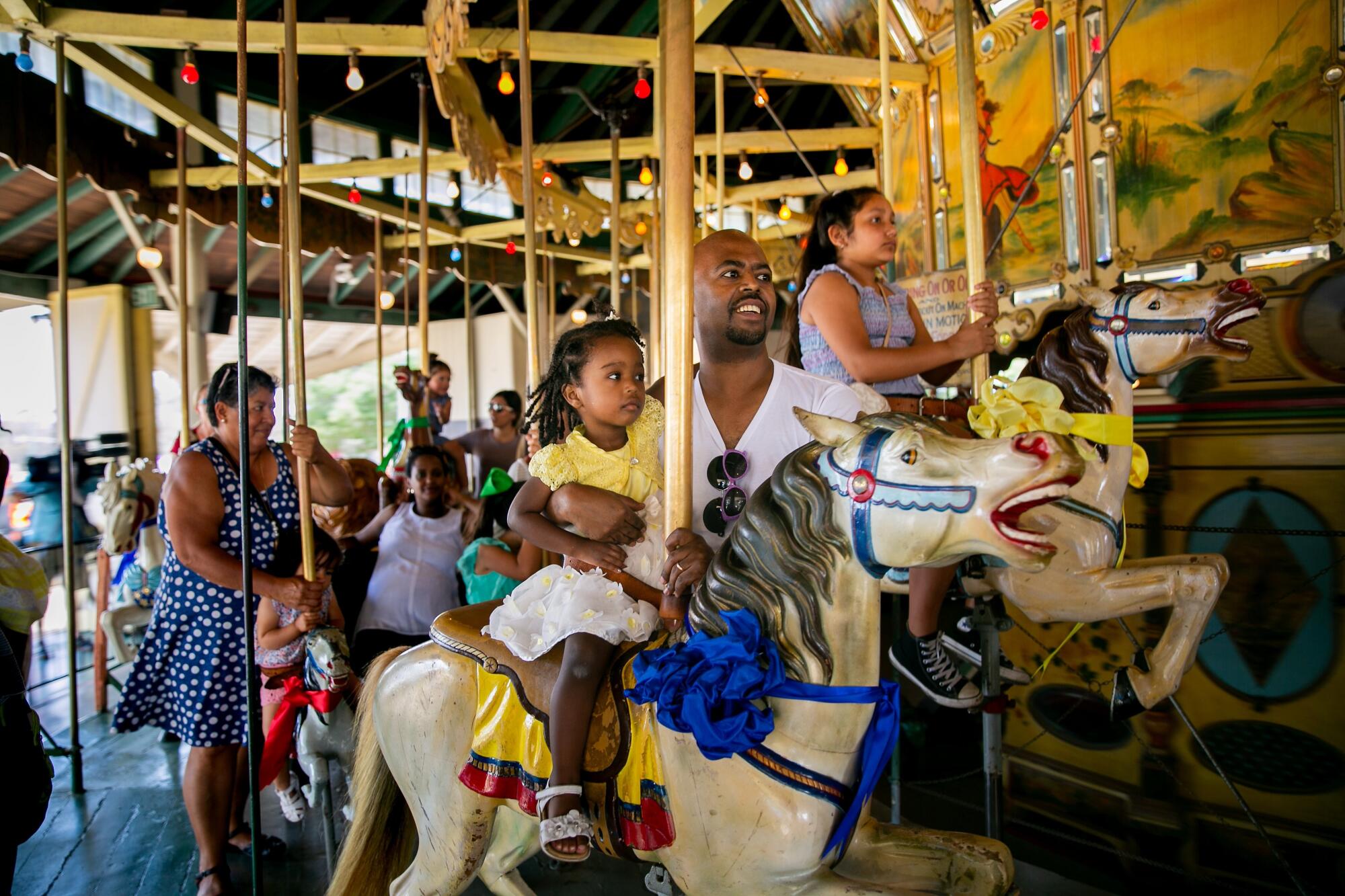
More to Read
Sign up for Essential California
The most important California stories and recommendations in your inbox every morning.
You may occasionally receive promotional content from the Los Angeles Times.














